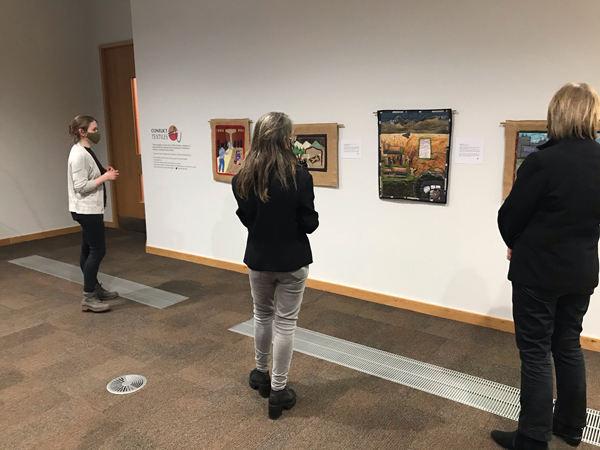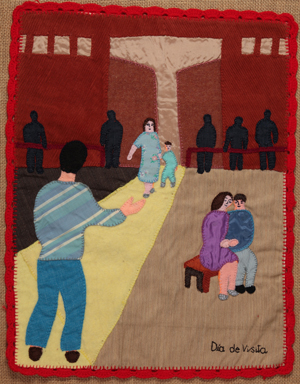Conflict Textiles Exhibition: McClay Library, QUB
The Human Rights Centre, along with the Senator George J. Mitchell Institute for Global Peace, Security and Justice, has supported the installation of an exhibition of arpilleras from the Conflict Textiles archive in QUB’s McClay Library.

Lauren Dempster (QUB), Roberta Bacic (Conflict Textiles) and Paula Devine (ARK) (L-R) viewing the Conflict Textiles exhibition at the McClay Library. (Photograph: Gillian Robinson).
Conflict Textiles, Human Rights and the International Day for the Right to Truth
The Conflict Textiles archive is made up of almost 400 ‘conflict textiles’ from around the world. These include arpilleras (three-dimensional appliquéd tapestries), quilts and wall hangings.i You can learn more about the archive in this 2020 LawPod episode.
Conflict textiles are rooted in efforts to highlight and condemn human rights violations. The exhibition at the McClay Library comprises four arpilleras. Originating in Chile, arpilleras were created by women, often working collectively, to depict the human rights violations being perpetrated under the Pinochet regime.ii They are, as Roberta Bacic, curator of the collection has described, ‘‘a tactile demonstration and picture of human rights violations that have affected people.”iii In addition to depicting violations, these textiles have a role in activism and mobilisation against human rights violations. As Director of the Human Rights Centre, Dr Cheryl Lawther, remarked at the launch of the exhibition, these textiles “highlight not only the different forms that human rights violations can take, but the ways in which human rights, and the ways in which human rights violations can be approached and campaigned for from a variety of different vantage points.”
The launch of the exhibition was timed to coincide with the International Day for the Right to Truth Concerning Gross Human Rights Violations and for the Dignity of Victims. Conflict textiles have a significant truth-telling function. As Roberta Bacic emphasises, the arpilleras are testimonies that are mostly “written in the first person”iv by those directly impacted by human rights violations. These textiles are a medium by which women can ‘embroider their protest and grief’v and they have the power to ‘convey…difficult and unsettling knowledge.’vi The textiles provide a platform for truth-telling, and as Prof Brandon Hamber explained at the launch, “they tell stories of people who often don’t have voices.”

Día de Visita / Day of Visit
Chilean arpillera, Victoria Diaz Caro, 1983
Oshima Hakko Museum collection, Japan. In the care of Conflict Textiles collection
Photo Martin Melaugh, © Conflict Textiles
https://cain.ulster.ac.uk/conflicttextiles/
QUB Exhibition and Launch
The exhibition at the McClay Library is a permanent rotating exhibition. The textiles on display will be changed over time to capture different themes and issues. The four textiles currently displayed are:
- Día de Visita which depicts a political prisoner greeting his family on visiting day at a Chilean prison during the Pinochet era.
- Centro de Torturas Cuatro Alamos which shows an individual being tortured, also during the time of the Pinochet regime.
- Shannonwatch highlights the ongoing issue of extraordinary rendition, focusing on the protests against the use of Shannon airport in the west of Ireland for rendition flights.
- Digital Death portrays the impact of drone warfare on civilians.
The exhibition was launched on 24th March with contributions from Dr Lauren Dempster, Prof Brandon Hamber, Dr Cheryl Lawther and Prof Kieran McEvoy. Roberta Bacic provided an overview of the exhibition and in addition Deborah Stockdale, the creator of two of the textiles, spoke to the creation of Shannonwatch. You can watch the launch here.
Future events linked to the exhibition will be advertised via the Human Rights Centre website and social media. You can learn more about the Conflict Textiles archive via its website, where you can also view a digital archive of textiles.
[i] Conflict Textiles (2021) ‘Textiles.’ Available at: https://cain.ulster.ac.uk/conflicttextiles/textiles/.
[ii] Conflict Textiles (2021) ‘Textiles.’ See also Dayna L. Caldwell (2012) ‘The Chilean Arpilleristas: Changing National Politics Through Tapestry Work,’ Textiles and Politics: Textile Society of America 13th Biennial Symposium Proceedings, Washington DC, 18-22 September.
[iii] LawPod (2020) ‘Episode 71 – Conflict Textiles: Following the Footsteps of the Disappeared.’ Available at: http://lawpod.org/?name=2020-11-12_conflict-textiles.mp3.
[iv] LawPod (2020) ‘Episode 71’.
[v] Amanda Strauss (2015) ‘Treading the Ground of Contested Memory: Archivists and the Human Rights Movement in Chile,’ Archival Science 15:4 (369-397), 381.
[vi] Christine Andrä (2020), ‘Knowing Through Needlework: Curating the Difficult Knowledge of Conflict Textiles,’ Critical Military Studies 6:3-4 (341-359), 348.
